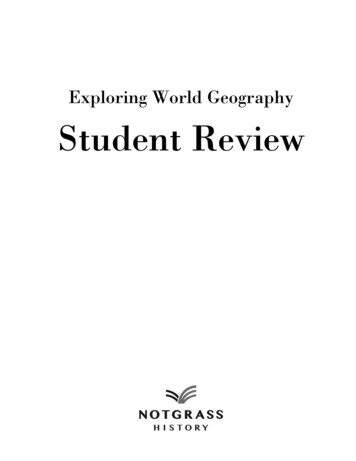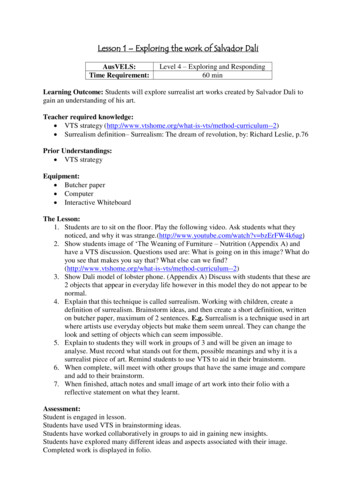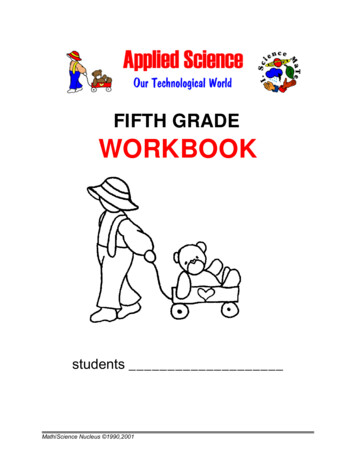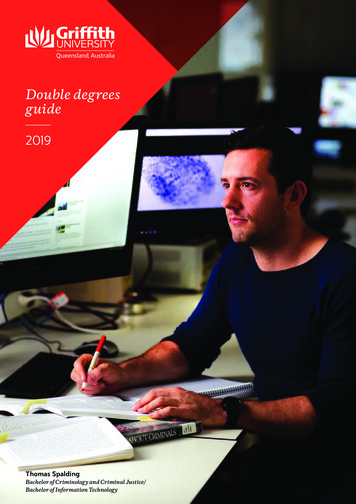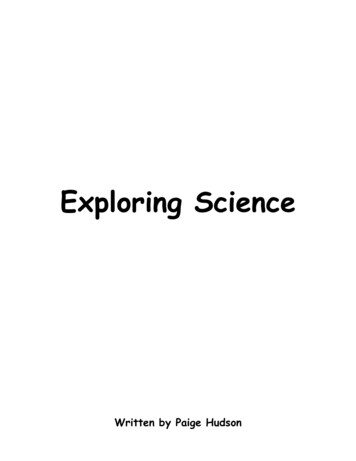
Transcription
Exploring ScienceWritten by Paige Hudson
Exploring ScienceI wrote this program with the goal of giving you the tools to gently introduce your studentto the world of science. Your early elementary student will work on increasing their observationskills as they learn from different topics within the major disciplines of science. ExploringScience lays out weekly topics to study along with a main idea to emphasize. Each week includesan introduction, an experiment and nature study plans, plus additional books and activities.Exploring Science is designed to be used with your 4 or 5 year old student.Introducing the topic:The introductions in this guide include simple explanations, demonstrations and/or guidedobservations for you to use when introducing your students to the week’s topic. There is a scriptfor you to read, but feel free to use your own words or edit the script as you communicate theinformation. The main purpose of introducing the topic is to share with your student what theywill be studying for the week.Experiments:The experiments are the core of this program and are designed to help your student seescience in action. All of the experiments come from Science Play. The goal is to demonstratescience for your student, allowing them to discover more about the world around them. Don’texpect them to be able to predict the outcome or to draw abstract conclusions at this age. Insteadallow them to observe and tell what they have learned. All the experiment pages you will needare found in the student notebook pages.Nature study:The nature studies will also coordinate with the weekly topic. The purpose of these naturestudies is to have your student learn about the world around them through discovery andobservation. Your student will make their own science notebook on Week 1 of Unit 1. They willuse this science notebook throughout the year as their nature study journal. Allow them to drawwhat they would like or glue a picture on the page instead. At this stage, it is best for you to writedown their observations for them.Additional Books and Activities:The additional books are optional ones that will coordinate with your weekly topic. Theyare suggestions that you can get from your local library. I have not previewed each and everybook, so be sure to do so before you read them to your student. The additional activities includecraft ideas, snack options and projects that will tie into the weekly topic.Student Notebook Pages:The student notebook pages are sold separately. They include coloring, experiment andactivity pages to use for each week. The following is a description of how each page is designedto be used. Coloring page: Read the main idea at the bottom of the page to your student and have themcolor the picture.
Experiment page: Have your student tell you what they learned from the experiment andwrite it down for them on the lines provided. Activity page: Have your student draw a picture or paste in a picture of the craft projectthey made on the sheet provided.How to schedule this study:I wrote Exploring Science as a topical study, each week stands alone, but also fits into a 4week unit. This gives you the teacher complete freedom in which order you want to do thisstudy, how much you want to do in a week and how many days you want to study science perweek. This is so that you can pick and choose activities that interest your student. I wouldsuggest scheduling science for 2(20 min) days a week or 5(10 min) days a week. Each week Ihave included two sample schedules to give you an idea of how you could schedule your time.You can choose to use these as your guide or create your own schedule using one of the blankscheduling templates in the Appendix at the back of this guide.How to include an older student:If you want your older student to do this study along with your other students, here aresome suggestions to increase the difficulty of this program so that it is appropriate for them. have them read the additional books to your younger student have them read about the weekly topic in the Usborne Internet-linked ScienceEncyclopedia have them write full narrations as well as do a more detailed write-up for the experimentusing the pages included in the Appendix at the back of this guideFinal Thoughts:My hope is that this curriculum will spark your student’s interest in learning more aboutthe natural world around them. The topics covered in this program will be examined further insubsequent programs. As the author and publisher of this curriculum I encourage you to contactme with any questions or problems that you might have concerning Exploring Science atinfo@elementalscience.com. I will be more than happy to answer them as soon as I am able.Also, be sure to check the Elemental Science Yahoo Group, under the Exploring Science Filessection for some of the pictures and additional files that are used in this program so that you don’thave to create them. I hope that you and your student will enjoy exploring the world of science!
Copyright PageAll contents copyright 2011 by Elemental Science, Inc. All rights reserved.No part of this document or the related files may be reproduced or transmitted in anyform, by any means (electronic, photocopying, recording, or otherwise) without theprior written permission of the author. The author does give permission to the originalpurchaser to photocopy all supplemental material for usewithin their immediate family only.Limit of Liability and Disclaimer of Warranty: The publisher has used its best effortsin preparing this book, and the information provided herein is provided "as is." ElementalScience makes no representation or warranties with respect to the accuracy orcompleteness of the contents of this book and specifically disclaims any impliedwarranties of merchantability or fitness for any particular purpose and shall in no eventbe liable for any loss of profit or any other commercial damage, including but notlimited to special, incidental, consequential, or other damages.Trademarks: This book identifies product names and services known to be trademarks,registered trademarks, or service marks of their respective holders. They are usedthroughout this book in an editorial fashion only. In addition, terms suspected of beingtrademarks, registered trademarks, or service marks have been appropriatelycapitalized, although Elemental Science cannot attest to the accuracy of thisinformation. Use of a term in this book should not be regarded as affecting the validityof any trademark, registered trademark, or service mark. Elemental Science is notassociated with any product or vendor mentioned in this book.
Book ListThe following book is what I used when planning this program. I recommend that youpurchase or download it because all of the experiments, plus many of the activities, come from it. Science Play (Williamson Little Hand Book) by Jill Frankel HauserOverview of the Areas of Sciences StudiedThe following areas of science will be studied through discovery and observationthroughout the year. Each unit contains 4 weeks’ worth of material to study. Unit 1: Exploring the World Around MeUnit 2: Exploring WaterUnit 3: Exploring AirUnit 4: Exploring WeatherUnit 5: Exploring PlantsUnit 6: Exploring the EarthUnit 7: Exploring ChemistryUnit 8: Exploring SoundUnit 9: Exploring Motion
Unit 4:Exploring WeatherLesson Plans
Exploring Science Unit 4 Week 1Topic: Sunny Days & ShadowsMain Idea: A shadow is created when an object blocks out the Sun’s light.Introducing the Topic:Have a hand puppet and a flashlight ready on the table. Have the student come and sit down. Tellyour student, “This week we are going to look at shadows. See this flashlight; when I shine it on thetable, you can see a beam of light. Now, you put this puppet on your hand and put it between theflashlight and the table. (Make sure your student leaves enough room so that a shadow is created.)Look you created a shadow! Your hand puppet blocked the light from the flashlight and a shadowappeared below. That is because a shadow is created when an object blocks out a light source. TheSun is a giant light source for the Earth. When something blocks out the Sun’s light, a shadow is alsocreated. This week we are going to have fun with our shadows.” Then, have your student color thecoloring page found in the student pages on pg. 51.Experiment: Science Play pg. 52, “Sunny Day, Shadow Play”In this experiment your student will discover how their shadow changes as the day goes on. This isbecause the Sun changes position throughout the day, so the angle at which it is shining downchanges. Thus, their shadow length will also change. Be sure to mark where the top their feet werefor your first measurement, that way you can use it each time.Materials needed:o Sidewalk chalko Measuring tapeEach time you trace their shadow, have your student measure how long it is and tell you whether theirshadow was in front of, to the side or behind them. Record this information on the experiment sheetfound in the student pages on pg. 52 for them.Nature Study: ShadowsThis week your nature study will focus on finding shadows in nature. You will need to schedule yournature walk time for a sunny day. Outdoor time: Go on a nature walk outdoors. Have your student spot as many shadows as theycan. Then see if you can identify the object making the shadow (i.e. The very large shadow acrossa field is due to the tree or the house that is nearby.) Allow your student to collect a few naturesamples, such as leaves, rocks and acorns. Once you get home have them choose a dark color ofconstruction paper (red, blue or purple) and set in the direct sun. Then have your student arrangetheir objects on the paper. Check it in several hours to see if the nature objects have left theirshadows behind. (You could also do this activity with light sensitive paper, but it will be muchquicker.) Then allow your student to sketch what they want in their science notebook.Additional Books: What Makes a Shadow? (Let's-Read-and-Find. Science 1) by Clyde Robert Bulla and June Otani Nothing Sticks Like a Shadow by Ann Tompert and Lynn Munsinger A Sunny Day (First Step Nonfiction) by Robin Nelson The Sun: Our Nearest Star (Let's-Read-and-Find. by Franklyn M. Branley and Edward MillerAdditional Activities: Craft: Silhouette CollageHave your student choose a color of construction paper and tape it on the wall behindthem. Have them sit with their side facing the wall and shine a light directly on them. Trace the
shadow that their face makes. Cut it out, saving the outer piece for later use. Have your studentlook in a magazine for things that interest them and things that show how they feel. Cut them outand glue them onto the activity page on pg. 53 of the student pages. It is best if these picturesoverlap a bit. Once they are done, glue the construction paper cut-out on top, so that you see allthe things they like where the shadow of their face once was.Activity: Shadow GamesThis activity is explained on pg. 53 of Science Play.Scheduling Options:2-days a week:Day 1Introduce the topic:Read the section in the teacher’s guide andhave your student color the coloring pagein the student pages.Experiment:“Sunny day, Shadow Play” found inScience Play pg. 52. Complete theexperiment page from the student pages.Day 2Nature Study:Go on a nature walk for a shadow hunt.Make an entry in their science journalwhen you return.Additional Activity:Do the “Shadow Silhouette” activity.Have your student fill out the activity pagefrom the student pages.Supplies I Need for the Week: Day 1: hand puppet, flashlight, sidewalk chalk, measuring tape Day 2: construction paper, various magazinesThings I need to Prepare: 5-days a week:Day 1Introduce the topic:Read the section in theteacher’s guide andhave your studentcolor the coloring pagein the student pages.Day 2Day 3Learn More:Experiment:Choose one of the“Sunny Day,additional books toShadow Play”read to your student.found in ScienceThen do thePlay pg. 52.“Shadow Games”Complete theactivity.experiment pagefrom the studentpages.Supplies I Need for the Week: Day 1: hand puppet, flashlight Day 2: sidewalk chalk, measuring tape Day 4: construction paper, various magazinesThings I need to Prepare: Get library bookDay 4Additional Activity:Do the “ShadowSilhouette” activity.Have your studentfill out the activitypage from thestudent pages.Day 5Nature Study:Go on a nature walkfor a shadow hunt.Make an entry intheir science journalwhen you return.
Exploring ScienceA shadow is created when an objectblocks out the Sun’s light.Student Pages 51
Exploring Science“Sunny Day, Shadow Play”Time of DayLength & Locationof my shadowStudent Pages 52
Exploring ScienceSilhouette CollageStudent Pages 53
Exploring Science Unit 4 Week 2Topic: RainMain Idea: Rain is water falling from clouds in the sky.Introducing the Topic:Read the following 19th century nursery rhyme to your student Rain, Rain,Go away;Come again,April day;Little Johnny wants to play.Say to your student, “Do you know what rain is? (Answers will vary, praise them if they are correct.)That’s good; rain is water falling from clouds in the sky. Water evaporates from lakes and oceans. Itgoes up into the air and forms clouds. When those clouds get really heavy, they let go of some of thewater and it falls to the ground as rain. This week we are going to study rain.” Then, have yourstudent color the coloring page found in the student pages on pg. 54.(**Note: The above is a simplistic explanation of the water cycle as it will be studied more in depth inIntro to Science and in Earth Science & Astronomy for the Grammar Stage.**)Experiment: Science Play pg. 59, “Raindrop Landing Pad”In this experiment your student will discover what shapes raindrops make. This experiment is best ona rainy day, but you can simulate rain with an eye dropper and some water if need be.Materials needed:o Flouro Salto Aluminum panAfter your student observes the shapes the raindrops have made, have them trace those shapes on theexperiment sheet found in the student pages on pg. 55.Nature Study: RainThis week your nature study will focus on what rain does in nature. You will need to schedule yournature walk time for just after a rain shower. Outdoor time: Go on a nature walk outdoors after a rain shower. Have your student look forsigns that it has rained (water on the grass and leaves, puddles on the sidewalk or steam risingfrom the road). Point out these signs for them if they don’t see them on their own. Once youreturn home, allow your student to sketch what they want in their science notebook.Note: If you don’t mind getting wet, see pg. 58 of Science Play for directions on how to guide a“Rainy Day Safari”.Additional Books: Down Comes the Rain (Let's-Read-And-Find. Science: Stage 2 (Pb)) by Franklyn MansfieldBranley and James Graham Hale The Rain Came Down by David Shannon Rain (Weather Series) by Marion Dane Bauer and John WallaceAdditional Activities: Craft: Pitter Patter PaintThis activity is explained on pg. 59 of Science Play. You will need tempera paint, paperand rain. If it is not raining on the day you do this craft, simply use a water sprayer to simulate the
rain. You can use the activity page on pg. 56 of the student pages for this project or have yourstudent glue their completed sheet onto that page.Snack: Orange UmbrellasCut an orange into thin round slices, and then slice each round in half for the top of yourumbrella. Use pretzel sticks or thinly sliced apples for the handle of your umbrella. Eat andenjoy!Activity: Measure the RainThis activity is explained on pg. 59 of Science Play. You will need a clear jar, a ruler anda permanent pen.Scheduling Options:2-days a week:Day 1Introduce the topic:Read the section in the teacher’s guide andhave your student color the coloring pagein the student pages.Experiment:“Raindrop Landing Pad” found in SciencePlay pg. 59. Complete the experimentpage from the student pages.Day 2Nature Study:Go on a nature walk to see the outdoorsafter the rain. Make an entry in theirscience journal when you return.Additional Activity:Do the “Pitter Patter Paint” activity. Haveyour student fill out the activity page fromthe student pages.Supplies I Need for the Week: Day 1: flour, salt, aluminum pan Day 2: tempura paint, paperThings I need to Prepare: 5-days a week:Day 1Day 2Day 3Learn More:Experiment:Introduce the topic:Choose one of the“Raindrop LandingRead the section inadditional books toPad” found inthe teacher’s guideread to your student.Science Play pg.and have your studentThen do the59. Complete thecolor the coloring“Measure the Rain”experiment pagepage in the studentactivity.from the studentpages. Then makepages.“Orange Umbrellas”for snack.Supplies I Need for the Week: Day 1: orange, pretzel sticks or apple slices Day 2: flour, salt, aluminum pan Day 3: clear jar, ruler, permanent pen Day 4: tempura paint, paperThings I need to Prepare: Get library bookDay 4Additional Activity:Do the “Pitter PatterPaint” activity.Have your studentfill out the activitypage from thestudent pages.Day 5Nature Study:Go on a nature walkto see the outdoorsafter the rain. Makean entry in theirscience journal whenyou return.
Exploring ScienceRain is water falling from clouds in the sky.Student Pages 54
Exploring Science“Raindrop Landing Pad”Student Pages 55
Exploring SciencePitter Patter PaintStudent Pages 56
Exploring Science Unit 4 Week 3Topic: CloudsMain Idea: Clouds are made from water vapor.Introducing the Topic:Read the following “The Cloud” by Percy Shelly (in the Appendix) to your student, but don’t tellthem the title of the poem. After you are finished, say to your student, “Can you guess what thatpoem was about? (Answers will vary, praise them if they are correct.) That’s good; that poem wasall about clouds. Did you know that clouds are made from water vapor? This week we are going tospend some time looking at clouds.” Then, have your student color the coloring page found in thestudent pages on pg. 57.Experiment: Science Play pg. 60, “Cloud-in-a-bag”In this experiment your student will discover how clouds form. They will also create their own minirainstorm.Materials needed:o Soil and small plantso Plastic resealable bago Spoono WaterAfter your student observes their mini-rainstorm, take a picture and have them tell you what theyhave learned. Glue the picture onto the experiment sheet found in the student pages on pg. 58 andwrite what they learned on the lines provided.Nature Study: CloudsThis week your nature study will focus on clouds. You will need to schedule your nature walk timefor when there are clouds in the sky Outdoor time: Go on a nature walk outdoors to hunt for clouds. Have your student observe theclouds and see if they can find shapes in them. Be sure to point out that clouds are constantlymoving and changing. Once you return home, allow your student to sketch what they want intheir science notebook.Additional Books: Clouds (Let's-Read-and-Find. Science 1) by Anne F. Rockwell and Frane Lessac Little Cloud (Picture Puffins) by Eric Carle The Cloud Book by Tomie dePaolaAdditional Activities: Craft: Fluffy CloudsYou will need light blue paint, paintbrush, glue and cotton balls. Have your student paintthe activity page on pg. 59 of the student pages light blue all over. Once the paper dries have themstretch out the cotton balls into various shapes. Then glue them onto the activity page as clouds. Snack: CloudsBeat two egg whites and ¼ tsp of cream of tartar until stiff peaks form; add in ½ tsp vanillaand 1/3 cup sugar. Beat until well incorporated. Drop spoonfuls on a cookie sheet lined with foil.Bake at 325oF for 10 min, then turn off the oven (don’t open the oven door) and let the clouds sitin the oven for 50 more minutes. Remove and eat. (You can also dye some vanilla pudding lightblue and float your clouds in the sky.)
Activity: Cloud MatchingCut out the clouds on the Cloud Matching sheet found in the Appendix. Have your studentmatch them by color and/or by size.Scheduling Options:2-days a week:Day 1Introduce the topic:Read the section in the teacher’s guide andhave your student color the coloring pagein the student pages.Experiment:“Cloud-in-a-bag” found in Science Playpg. 60. Complete the experiment pagefrom the student pages.Day 2Nature Study:Go on a nature walk to see the clouds.Make an entry in their science journalwhen you return.Additional Activity:Do the “Fluffy Clouds” activity. Haveyour student fill out the activity page fromthe student pages.Supplies I Need for the Week: Day 1: soil and small plants, resealable plastic bag, spoon, water Day 2: light blue paint, paintbrush, glue and cotton ballsThings I need to Prepare: 5-days a week:Day 1Introduce the topic:Read the section inthe teacher’s guideand have your studentcolor the coloringpage in the studentpages. Then make“Clouds” for snack.Day 2Experiment:“Cloud in-a-bag”found in SciencePlay pg. 60.Complete theexperiment pagefrom the studentpages.Day 3Learn More:Choose one of theadditional books toread to your student.Then do the “CloudMatching” activity.Day 4Additional Activity:Do the “FluffyClouds” activity.Have your studentfill out the activitypage from thestudent pages.Day 5Nature Study:Go on a nature walkto see the clouds.Make an entry intheir science journalwhen you return.Supplies I Need for the Week: Day 1: 2 eggs, cream of tartar, vanilla, sugar, (optional vanilla pudding, blue food coloring) Day 2: soil and small plants, resealable plastic bag, spoon, water Day 3: clouds cut out from the Appendix Day 4: light blue paint, paintbrush, glue and cotton ballsThings I need to Prepare: Get library book
Exploring ScienceClouds are made from water vapor.Student Pages 57
Exploring Science“Cloud in a Bag”Picture of my bagWhat I learned about clouds and rain Student Pages 58
Exploring ScienceFluffy CloudsStudent Pages 59
Exploring Science Unit 4 Week 4Topic: WeatherMain Idea: Weather changes with the seasons.Introducing the Topic:Sing the following song about seasons with your student.Winter, Spring, Summer, Fall(to the tune of "This Old Man")Winter, Spring, Summer, FallThere are seasons, four in all.Weather changes, sun and rain and snow,Leaves fall down and flowers grow.Winter, Spring, Summer, FallThere are seasons, four in all.Look outside and you will seeJust what season it will be!After you are finished, say to your student, “This week we are going to talk about weather. Did youknow that the weather changes with the seasons? In winter, it’s cold and sometimes snows. In springit’s warm and the flowers and trees start to bloom. In summer, it’s hot and things really start to grow.In the fall, it’s starts getting cool and the leaves fall off the tree. This week we are going to look atour weather.” Then, have your student color the coloring page found in the student pages on pg. 60.Experiment: Science Play pg. 64, “Weather Watch”In this experiment your student will watch the weather for the week.Materials needed:o Colored PencilsHave your student observe the weather each day for five days. Then have them glue the weatherwatch stickers, found in the student pages on pg. 63, onto the experiment sheet found in the studentpages on pg. 61.Nature Study: WeatherThis week your nature study will focus on the weather. Outdoor time: Go on a nature walk outdoors. While on your walk, ask your student questionsabout the weather (i.e. Is it hot or cold today? Is it cloudy or sunny? When was the last time itrained?) Once you return home, have your student sketch what they want in their sciencenotebook.Additional Books: Oh Say Can You Say What's the Weather Today?: All About Weather (Cat in the Hat's LearningLibrary) by Tish Rabe and Aristides Ruiz What Will the Weather Be? (Let's-Read-and-Find. Science 2) by Lynda Dewitt and CarolynCroll Flash, Crash, Rumble, and Roll by Franklyn M. Branley and True KelleyAdditional Activities: Craft: Seasons CollageMake a collage for the season you are in using pictures from magazines. For example, ifyou do this week during the winter, use pictures of snowflakes, bare trees, icicles, Christmas trees
and so on. Have your student glue their pictures on the activity page on pg. 62 of the studentpages. Craft: Weather MobileHave your student choose two sticks from outside for their mobile. Have them color theweather mobile templates from the Appendix while you secure their two sticks together in a crossshape. Then punch holes in each of the weather pictures and one to each of the four ends of thesticks.Activity: Weather HeadbandThis activity is explained on pg. 65 of Science Play. You will need a cardboard,construction paper and streamers.Scheduling Options:2-days a week:Day 1Introduce the topic:Read the section in the teacher’s guide andhave your student color the coloring pagein the student pages.Experiment:“Weather Watch” found in Science Playpg. 64. Complete the experiment pagefrom the student pages. (Observe daily.)Day 2Nature Study:Go on a nature walk to observe theweather. Make an entry in their sciencejournal when you return.Additional Activity:Do the “Seasons Collage” activity. Haveyour student fill out the activity page fromthe student pages.Supplies I Need for the Week: Day 1: colored pencils Day 2: magazine pictures, glueThings I need to Prepare: 5-days a week:Day 1Introduce the topic:Read the section inthe teacher’s guideand have your studentcolor the coloringpage in the studentpages. Then beginyour “WeatherWatch” experiment.Day 2Activity:Do the “WeatherMobile” activity.Continue your“Weather Watch”experiment.Day 3Learn More:Choose one of theadditional books toread to your student.Then do the“WeatherHeadband” activity.Continue your“Weather Watch”experiment.Supplies I Need for the Week: Day 1: colored pencils Day 2: markers, two sticks, string, glue, hole punch Day 3: cardboard, construction paper, streamers Day 4: magazine pictures, glueThings I need to Prepare: Get library bookDay 4Additional Activity:Do the “SeasonsCollage” activity.Have your studentfill out the activitypage from thestudent pages.Continue your“Weather Watch”experiment.Day 5Nature Study:Go on a nature walkto observe theweather. Make anentry in their sciencejournal when youreturn. Continueyour “WeatherWatch” experiment.
Exploring ScienceWeather changes with the season.Student Pages 60
Exploring Science“Weather Watch”My weather this week ent Pages 61
Exploring ScienceSeasons CollageStudent Pages 62
Exploring ScienceWeather Watch ySunnyCloudyStormyStudent Pages 63
Appendix
“The Cloud” by Percy ShellyII bring fresh showers for the thirsting flowersFrom the seas and the streams;I bear light shade for the leaves when laidIn their noonday dreams.From my wings are shaken the dews that wakenThe sweet buds every one,When rocked to rest on their Mother's breast,As she dances about the sun.I wield the flail of the lashing hail,And whiten the green plains under;And then again I dissolve it in rain,And laugh as I pass in thunder.III sift the snow on the mountains below,And their great pines groan aghast;And all the night 'tis my pillow white,While I sleep in the arms of the Blast.Sublime on the towers of my skiey bowersLightning my pilot sits;In a cavern under is fettered the Thunder,It struggles and howls at fits.Over earth and ocean with gentle motionThis pilot is guiding me,Lured by the love of the Genii that moveIn the depths of the purple sea;Over the rills and the crags and the hills,Over the lakes and the plains,Wherever he dreams under mountain or streamThe Spirit he loves remains;And I all the while bask in heaven's blue smile,Whilst he is dissolving in rains.IIIThe sanguine Sunrise with his meteor eyes,And his burning plumes outspread,Leaps on the back of my sailing rack,When the morning star shines dead:As on the jag of a mountain cragWhich an earthquake rocks and swingsAn eagle alit one moment may sitIn the light of its golden wings.And, when Sunset may breathe, from the lit seabeneath,Its ardours of rest and of love,And the crimson pall of eve may fallFrom the depth of heaven above,With wings folded I rest on mine airy nest,As still as a brooding dove.IVThat orbed maiden with white fire ladenWhom mortals call the MoonGlides glimmering o'er my fleece-like floorBy the midnight breezes strewn;And whenever the beat of her unseen feet,Which only the angels hear,May have broken the woof of my tent's thin roof,The stars peep behind her and peer.And I laugh to see them whirl and fleeLike a swarm of golden bees,When I widen the rent in my wind-built tent, -Till the calm rivers, lakes, and seas,Like strips of the sky fallen through me on high,Are each paved with the moon and these.VI bind the Sun's throne with a burning zone,And the Moon's with a girdle of pearl;The Volcanoes are dim, and the Stars reel andswim,When the Whirlwinds my banner unfurl.From cape to cape, with a bridge-like shapeOver a torrent sea,Sunbeam-proof, I hang like a roof;The mountains its columns be.The triumphal arch through which I march,With hurricane, fire, and snow,When the powers of the air are chained to mychair,Is the millioned-coloured bow;The Sphere-fire above its soft colours wove,While the moist Earth was laughing below.VII am the daughter of Earth and Water,And the nursling of the Sky:I pass through the pores of the ocean and shores;I change, but I cannot die.For after the rain, when with never a stainThe pavilion of heaven is bare,And the winds and sunbeams with their convexgleamsBuild up the blue dome of air,I silently laugh at my own cenotaph, -And out of the caverns of rain,Like a child from the womb, like a ghost from thetomb,I arise, and unbuild it again.
Cloud
Nature Study: Shadows This week your nature study will focus on finding shadows in nature. You will need to schedule your nature walk time for a sunny day. Outdoor time: Go on a nature walk outdoors. Have your student spot as many shadows as they can. Then see if you can identify the object making the shadow (i.e. The very large shadow across


